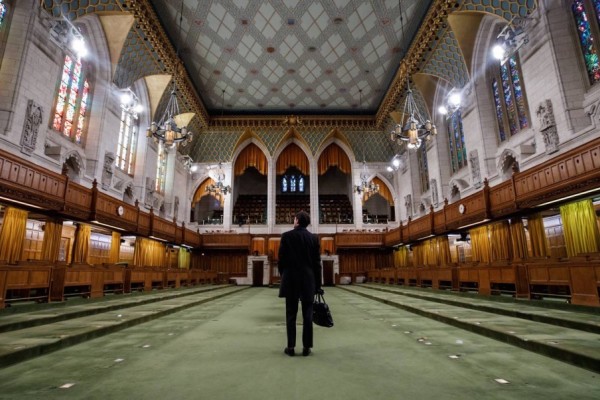Modern Monetary Theory could be the key to unlocking Canada’s economic future
MMT changes our understanding of how the Canadian government finances expenditures—and it’s not taxpayers

MMT has the potential to upset an economic order that posits governments are always subject to private enterprise, not the other way around. Photo by Jamie McCaffrey/Flickr.
As payments through the Canada Emergency Response Benefit (CERB) come to an end and are replaced by less substantial programs, there’s increasing anxiety around the precarity of work and a struggle for many Canadians to meet basic needs, compounded by rising household debt and the disappearance of sustainable work.
On September 12, news broke that a universal basic income (UBI) was a priority on the list of issues to be discussed at the upcoming Liberal Party convention in November. This is just the latest example of how economists and politicians are examining measures that could reshape Canada’s economy and financially protect Canadians in a post-COVID world.
However, UBI has its critics, and the question of how to pay for such programs, is a pressing one. Ultimately, this question underscores the reality of a monetary policy that can be seen as both arbitrary and harmful.
The solution? Modern Monetary Theory.
What is MMT?
In our current paradigm, the federal government covers deficit spending largely through the issuance of securities to the private sector, which accumulates interest and must be paid off. This is what creates government debt or the accumulation of debt. Modern Monetary Theory, or MMT, is a macroeconomic theory that equates government spending or fiscal policy to money creation or monetary policy.
MMT changes our understanding of how the Canadian government finances expenditures—and it’s not taxpayers. Although taxation plays an important role when it comes to inflation and demand for the Canadian dollar, MMT states that federal government expenditures on programs and services are financed by the Canadian government itself.
In short, MMT posits that governments do not tax and spend. They create money and spend it, with taxation as currency regulation. MMT, therefore, is best described as a restructuring of the understanding between those who create money and those who use money towards a more equitable and just balance.
MMT shows that federal deficits are good for the economy and are necessary, especially in times of financial crises. Government debt doesn’t actually make people poorer, and won’t burden future generations. Thinking broadly about pursuing policies under MMT, the federal government can pay off deficits by printing new currency, minimize its owed debt in foreign currency, and (in a majority of MMT-related economic circles) stop creating more debt by halting issuances of new bonds or other securities to the private sector. In effect, the government creates money instead of borrowing it, and having an understanding of how MMT works and functions, can ensure that every dollar spent is actualized in the economy—expanding programs and services, implementing and paying for a “Green New Deal”—and that ultimately we move towards the goal of full employment. Thus, MMT provides an answer to the question “How will you pay for it?”
Critics of MMT describe it as a recipe for hyperinflation, but those who push it double down on an MMT-driven economy’s ability to decrease the supply of money via taxation and other methods, in lieu of quantitative easing. Other criticisms include the potential for loss of confidence in a country’s currency, however that has been occurring without the implementation of MMT regardless. MMT is also not a blank check—its constraints are articulated by actualized growth of physical and productive resources. Things like land, factories, resources, and technology limit growth, and inflation is staved off as long as the government isn’t spending more than its capacity can allow.

We have the power
It’s fair to say that Canada has long been operating in an environment that would be easy to switch over to MMT, but this fact has only been articulated more forcefully in the midst of an ongoing global pandemic.
The right-wing in Canada frames the national debt as a particularly troubling thing: it identifies our total debt burden as having increased to $1.5 trillion in the last year. This number is trotted out largely to justify austerity measures and cuts that allow the business sector to increase profits through privatization. Austerity and the selling-off of public services and resources is a hallmark of neoliberal economics, and is largely the norm in the economies of “developed countries.” Additionally, the supposed risk of inflation affects the future value of yields based on interest, bonds, and the trading of securities, along with a significant impact on the profits of the entire banking sector, along with the ability of private enterprise to both monopolize and allocate resources for its own benefit.
Through its current issuance of bonds, the federal government pays up to $26 billion on interest, which both limits its ability to govern, and in cases of recession, necessitates more borrowing. MMT argues the deficit is largely a non-issue (a scare tactic more than anything) that is wielded to enrich big business. It is also worth noting that Canada has the lowest net debt burden among G7 countries.
The United States financed its enormous corporate bailout through the creation of currency sold on bond markets, roughly to the tune of $3 trillion, which must be paid back with interest. This is decidedly in favour of stimulating the private sector and maintaining employment, but ultimately results in financial restructuring that upends the job market and brings back employment at a significantly lower compensation than it was at before, while bolstering the finance, insurance, and real estate sectors through bailouts and quantitative easing (all while Americans ultimately get a fraction of the money generated) often with strings attached. With more money supplied and lower interest rates in the US, it also makes loans easier to obtain, shoring up things like mortgages and loans.
In Canada, the situation is not dissimilar, but with one key difference: the federal government is financing its own debt during COVID-19 by purchasing a significant amount of bonds from the reserve directly, instead of just selling them to the private sector. This is described as “monetary financing,” and the interest attributed to these ouroboros style loans is largely smoke and mirrors meant to maintain confidence in the Canadian dollar for investment. This has occurred since the formation of the Bank of Canada in 1934, though the percentage of money raised through monetary financing has decreased severely, particularly at the onset of neoliberal economics. It is, however, still significant.
The federal government could loan itself money at zero percent interest through the Bank of Canada and return that money to curb inflation, paying for necessary services and increased employment. In effect, it could maintain a money-goes-in-money-goes-out system, without conforming to the reactionary notion of “good, austere fiscal governance,” which often results in severe damage to Canadian livelihoods. MMT would significantly remove barriers to fully funding healthcare, infrastructure, a Green New Deal, community investment, and social services.
Australian Economist and MMT pioneer Bill Mitchell has described Canada as a potential poster child for MMT implementation.
Illustration courtesy of PolitiCoast, a politics podcast started by by Ian Bushfield and Scott de Lange Boom.
UBI versus MMT
Under a UBI, the focus on government issuance of currency is largely directed towards purchasing power, rather than MMT, which maintains full employment as a core tenet. The two are interlinked: UBI could not exist outside of an MMT environment, because of the need to continually print money that would then be deployed to every Canadian.
It’s also throwing money at the problem.
Full employment, which could also be implemented in an MMT economy through a guaranteed jobs program, both limits price adjustment (landlords couldn’t increase rent pegged to the extra thousand dollars in someone’s purse, for example), and is an intermediary between inflation and direct wealth generated by individuals. An employment guarantee has the added benefit of providing a baseline standard of employment that has the potential to eliminate precarious work and underemployment. The implementation of MMT would also serve as a net benefit with less risk of malpractice and drastic manipulations of pricing.
The idea of a jobs guarantee has been attempted before, most notably in Argentina, with mixed results amidst a recent economic upheaval. The lesson from Argentina, however, is not that a jobs guarantee is inherently disastrous, it’s that no economic restructuring can be done through halfway measures. Argentina’s failure in implementing a universal jobs guarantee largely stems from historic economic issues related to colonialism that Canada does not suffer from, most notably a lack of monetary sovereignty.
Some proponents of UBI promote the measure as a means to underfund or cut social programs in favour of a single “egalitarian” benefit. UBI is not a fundamental restructuring of the way society deals with capitalism—it could potentially entrench it further, by cutting cheques in lieu of funding services accountable to the public.
While the Liberal Party’s full UBI policy has yet to be revealed, it’s not difficult to imagine their version of basic income as a neoliberal tool to mask sharper austerity, rather than a value-added social program for Canadians.
MMT, on the other hand—in concert with, say, public banks—would create ample opportunities to both expand economic mobility while preventing banking sector malfeasance in favour of private profit. Public banks promote lending on interest without the promotion of collateral, credit, or the ability to repackage lending in the form of securities. There’s even an active precedent for it.
This isn’t everything
It’s important to recognize that MMT is not a panacea for how governments should function.
Ultimately, MMT, UBI, and any other economic restructuring that maintains a reliance on a private sector is ripe for exploitation and can be used as an excuse to not target the one percent who maintain control over our economic order and exploit workers for the wealth they generate.
MMT could establish a federal jobs program, but that shouldn’t be an excuse to not nationalize other industries. Under MMT, it would still be necessary for billionaires and millionaires to pay more taxes, ensure that their money is not being offshored, that banks have tighter regulation, and that exploitation of the planet by Canadian industry is halted in totality. What’s more, outside money created by things like futures markets must be curbed aggressively in order for this to work.
MMT is a tool in service of a larger social project, and shouldn’t be treated as the be-all-end-all of equity, as many reactionaries have posited and positioned UBI to be.
Many on the left will ask for a total upheaval to our economic order in the form of planned economies, full-scale nationalization, or simply revolution. Given the overall lack of progress made on that front, however, our current climate and the declining health of both people and the planet, asking for those things may be optimistic.
Drastic, intermediate steps to fix the situation we find ourselves in may be necessary. Those steps must involve policy that leaves the state with no excuse for not tackling climate change, unemployment, health and economic precarity.
MMT has the potential to upset an economic order that posits governments are always subject to private enterprise, not the other way around. It’s not the full scale of change that may still ultimately be necessary, but it is a sharp turn away from the neoliberal economic order that has dominated now for several decades.
Canada is in a unique position to implement MMT, perhaps better than any country in the world. Elements of UBI have been tested before, but never all of them in concert. With increasing corporate capture of our everyday lives and the states that govern us, it may be time to try something new—even if it doesn’t take us all the way to a truly egalitarian and equitable society.
This article was completed with support from Garry Sran, who is completing his PhD dissertation in economics at York University.
Abdul Malik is a screenwriter and journalist. You can follow him on Twitter @socialistraptor and listen to his podcast on sports and politics, @offcourtpod.







_600_400_90_s_c1.jpg)


